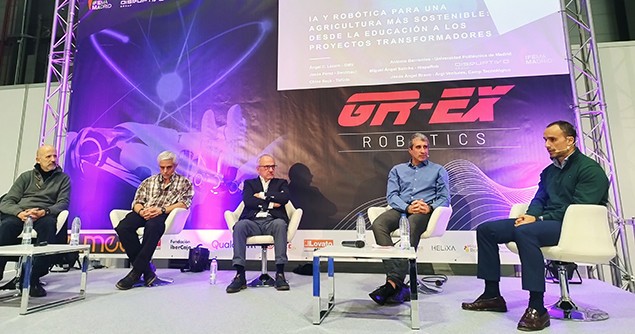The Versatility of Autonomous Robotics in Agriculture: Harvesting Olives or Detecting the Ripeness of Grapes

The food and agriculture industry is experiencing a turning point because of the technological advances taking place in areas such as robotics and artificial intelligence. This is leading to new developments such as drones that can monitor crops, autonomous vehicles performing work in the fields, and collaborative robots that assist with harvesting operations. In agriculture, the primary aim of applying technologies based on automation and robotics is to allow the simplest and most repetitive tasks to be performed, as a way to increase production efficiency and avoid labor shortages.
To help address these topics, the recent Global Robot Expo, organized by HispaRob, included a roundtable discussion on “AI and Robotics for More Sustainable Agriculture: From Education to Transformational Projects”. Ángel C. Lázaro, Head of Robotics and Automation for GMV’s Industry sector, took part in that discussion by sharing the company’s perspectives. He also provided examples of the applied robotics projects GMV is now conducting as public-private collaborations with universities and research centers.
The participants in the roundtable presented real‑life cases where automation and robotics are helping to create a more efficient and sustainable food and agriculture industry, through advances in STEM education, technologies, production systems, and software. One example of this is GMV’s new uPathWay product, which is a cloud-based solution for mobile autonomous robotics. By applying data and algorithms to train the software, great versatility can be achieved in terms of the types of outdoor work performed, such as harvesting olives in orchards and detecting the ripeness of grapes in vineyards.
The use of artificial vision and machine learning is essential for applying robotics in this way, to allow adaptation to a range of agricultural environments where traditional harvesting tasks are very time-consuming and labor-intensive. Automated harvesting work requires the use of robotic arms fitted with clamps or claws, which must be mobile enough to reach the foliage, and also careful enough to avoid damaging the product.
As an example, in the project known as AgrarIA a platform is being used to test application of these technologies throughout the food and agriculture value chain, for tasks involving transportation, logistics, manipulation, maintenance, and inspection. This project is being funded by Spain’s Ministry of Economic Affairs and Digital Transformation as part of the country’s Recovery, Resilience, and Transformation Plan, specifically through the R&D Missions in Artificial Intelligence Program of the State Secretariat for Digitalization and Artificial Intelligence (SEDIA) (file no. MIA.2021.M01.0004).